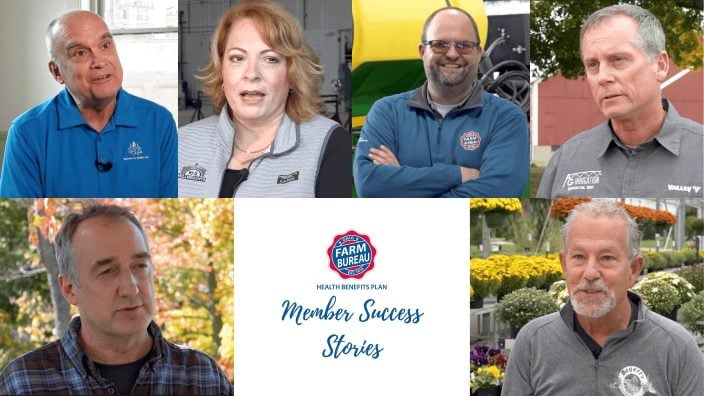Farmer’s Guide to Trucking Regulations available to Ohio Farm Bureau members
The guide includes a farm driver checklist, overview of state and federal regulations and exemptions, CDL qualifications and more.
Read More
I don’t know about you, but grocery shopping is one of those tasks that I dread. I’m that crazy lady you see in the store with a heaping grocery cart, picking up my groceries that are falling off the stack, while trying to figure out how to get a case of water to squeeze in, or on, or under. I do one big trip every few months, then pick up my essentials at the local convenience store down the road, because I hate taking the time out of my hectic schedule to make trips to the store.
It’s hard enough making lists of what you need (which ultimately I end up forgetting on my refrigerator or even in my vehicle in the parking lot), but going grocery shopping means needing a meal plan, or at least meal ideas right? Lordy, I’m lucky enough to have them fed.
Now think back to your most recent trip down the meat aisle of the grocery store or the case at your local butcher. How many different labeling terms did you encounter, How many of them do you really understand?
So today, I’m going to talk about labeling terms, and because there are so many terms, I’m going to address meat and poultry labeling terms specifically (information from USDA FSIS).
First, my favorite, and by favorite, I mean the labeling term that makes me lose my mind.
No hormones or hormone FREE: Wait, whaaaaattttt? First off, all meat and vegetables have hormones that occur naturally and well, there is no way to extract them. So that term should be No hormones added or administered. The term “no hormones administered” may be approved for use on the label of beef products if sufficient documentation is provided to the Agency by the producer showing no hormones have been used in raising the animals. Hormones are not allowed in raising hogs or poultry. Therefore, the claim “no hormones added” cannot be used on the labels of pork or poultry unless it is followed by a statement that says, “Federal regulations prohibit the use of hormones.”
NO ANTIBIOTICS (red meat and poultry):
The terms “no antibiotics added” may be used on labels for meat or poultry products if sufficient documentation is provided by the producer to the Agency demonstrating that the animals were raised without antibiotics.
NATURAL:
A product containing no artificial ingredient or added color and is only minimally processed. Minimal processing means that the product was processed in a manner that does not fundamentally alter the product. The label must include a statement explaining the meaning of the term natural (such as “no artificial ingredients; minimally processed”).
ORGANIC
“100 percent organic” can be used to label any product that contains 100 percent organic ingredients (excluding salt and water, which are considered natural).
Organic” can be used to label any product that contains a minimum of 95 percent organic ingredients (excluding salt and water). Up to 5 percent of the ingredients may be nonorganic agricultural products that are not commercially available as organic and/or nonagricultural products that are on the National List.
“Made with Organic ______” can be used to label a product that contains at least 70 percent organically produced ingredients (excluding salt and water). There are a number of detailed constraints regarding the ingredients that comprise the nonorganic portion.
FREE RANGE or FREE ROAMING:
Producers must demonstrate to the Agency that the poultry has been allowed access to the outside.
FRESH POULTRY:
“Fresh” means whole poultry and cuts have never been below 26 °F (the temperature at which poultry freezes). This is consistent with consumer expectations of “fresh” poultry, i.e., not hard to the touch or frozen solid.
The temperature of individual packages of raw poultry products labeled “fresh” can vary as much as 1 °F below 26 °F within inspected establishments or 2 °F below 26 °F in commerce.
Fresh poultry should always bear a “keep refrigerated” statement.
FROZEN POULTRY:
The temperature of raw, frozen poultry is 0 °F or below.
Stay tuned to future articles on labeling terms. I hope this helped clear up a little confusion on meat and poultry labeling terms.
Mandy Orahood is an Ohio Farm Bureau organization director serving Ashtabula, Geauga, Lake and Trumbull Counties. Mandy can be reached at [email protected].


The guide includes a farm driver checklist, overview of state and federal regulations and exemptions, CDL qualifications and more.
Read More


ODA will enroll 500,000 acres into the program for a two-week sign-up period, beginning April 22, 2024, through May 6, 2024. Contact local SWCD offices to apply.
Read More

Katie Share of Columbus has been named ExploreAg and Youth Development Specialist for Ohio Farm Bureau.
Read More

Mary Klopfenstein of Delphos has been named Young Ag Professional and Ag Literacy Program Specialist for Ohio Farm Bureau.
Read More

The plan has been updated to give sole proprietors access to more rate stability and a smart solution that offers potential savings on health care.
Read More

The American Farm Bureau Federation, in partnership with Farm Credit, is seeking entrepreneurs to apply online by June 15 for the 2025 Farm Bureau Ag Innovation Challenge.
Read More

Adele Flynn of Wellington has been elected treasurer of the Ohio Farm Bureau Federation and now holds the third highest elected office in Ohio’s largest and most influential farm organization.
Read More

Producers are urged to work with their veterinarian to practice enhanced biosecurity measures and review and limit cattle movements within production systems.
Read More

The changing seasons bring with them the need to thoroughly inspect pole barns for any damages that may have occurred during the winter months.
Read More

Hundreds of Ohio businesses and sole proprietors are raving about Ohio Farm Bureau’s Health Benefits plan with lower, predictable costs and easy enrollment and administration options.
Read More